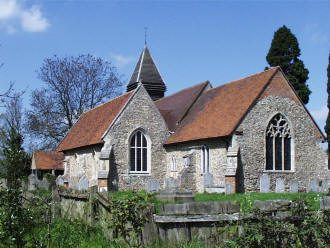
Forty Rectors in 1,000 Years
The archives tell us that the old church of St Mary’s in West Bergholt has had forty Rectors in the last thousand years and it is good to have such a full record. But there were many more whose names were not recorded. The deacons Robert, Alan and Richard who served the church in the 12th century (History of the Counties of England: The History Of Essex, OUP, Oxford, 2001, Vol. X, p35.) are the first we know about. But the old stone-built church of St Mary the Virgin had been there for more than a hundred years before they were born and there had been a wooden church before that. So it is likely there have been priests leading worship on this same patch of land since Christianity arrived in East Anglia in the seventh century.
This is an attempt to bring together all that is known about the religious life of West Bergholt during the life of the old church. For most of the clergy and their flock for most of the time, life in the church was much as it is today – a round of worship, good works, fund raising, worry about the fabric of the church and no doubt arguments about day to day activities. But in the twelve hundred years the present building has existed, many found themselves caught up in the doctrinal in-fighting of the Reformation and the rise of Puritanism and non-conformity. And it is, of course, mainly the conflicts and unhappy events that the archives record.
Village Hub
In Saxon and Norman times, the church was the hub of village activity. It was the most substantial building they had so it was used, not just for worship, but also for village meetings, merrymaking and dancing. The priest was often a man of humble birth and poorly educated. On weekdays, he worked in the fields like any other peasant. (The Oxford History of Victoria England: Domesday Book to Magna Carta, second edition, by A L Poole, Oxford at the Clarendon Press, pp59/60.) He was usually illiterate and shockingly ill paid and obliged to take money for masses. It was also likely that he would be married or least have “kept a hearth girl in his house who kindled his fire but extinguished his virtue.” (The Oxford History of Victoria England: Domesday Book to Magna Carta, second edition, by A L Poole, Oxford at the Clarendon Press, pp224/5).
Normans Arrive
When the Norman conquerers arrived in West Bergholt (then known as Bercholta or Copse on the Hill), the Lord of the Manor was Leofwin Croc who no doubt lived close to the church as later lords did. In the great land grab that followed the conquest, his land was confiscated and given by King William to one of his knights. It was a very long time before violent unrest against Norman rule disappeared from the countryside, but as the new rulers shared the same religion as the Anglo Saxons, the life of the church was able to go on much as before.
The first church on the site where the land begins to slope down into the Colne valley was a wooden one built in the mists of the Dark Ages. Traces of it were found by archaeologists digging in 1978. They also found graves which, to them, were evidence that the wooden building had been a church. The stone church, built early in the 11th century, was a simple single chamber with a rounded, or apsidal, chancel. It is thought that, even then, there was a wooden bell turret where the present one stands. Traces of that original building can be seen in the north wall where a doorway has been bricked up for another one (also closed up) to be built almost alongside. (Excavations at St Mary’s Church, West Bergholt, 1978, by Robin Turner, Essex County Council.) Much of that 12th century church survives in the present building. The Bercholta community at that time was tiny, consisting of about 30 tenants and slaves, but the church would also serve people living in the countryside for miles around.
13th – 14th Century
In the 13th century, the chancel was enlarged and squared off, perhaps to cope with a growing congregation. The church took on its present shape early in the 14th century when the south aisle and porch were built. (Excavations at St Mary’s Church, West Bergholt, 1978, by Robin Turner, Essex County Council.)
The Lords of the Manor of Bercholta owned the advowson, or right to appoint the priest, and from the 14th century onward there is a complete record of the men they appointed. The first Lord, Roger de Poitou, was banished from England for plotting against the King and in 1102, the first of the Sackvilles, the saintly Robert, took over the manor. He gave land from the manor to St John’s Abbey in Colchester and in 1137 became a monk himself.

